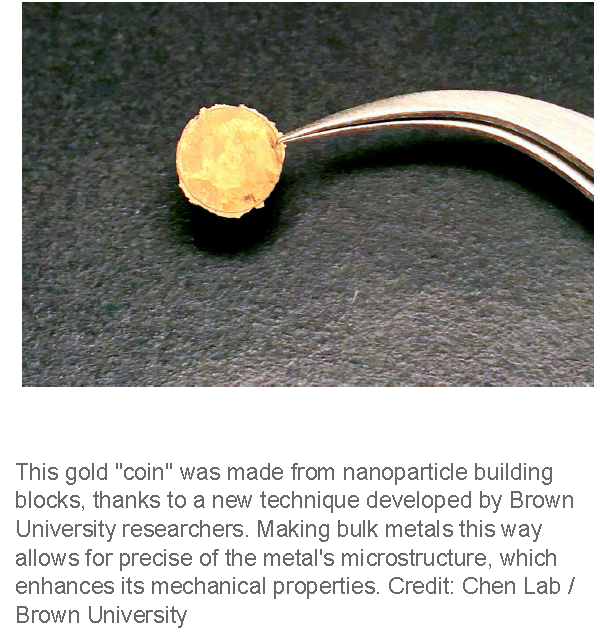博文
新技术从纳米粒子制造超硬金属
||
新技术从纳米粒子制造超硬金属
诸平
据美国布朗大学(Brown University)2021年1月23日提供的消息,该大学的研究人员已经开发出一种新技术,他们可以用纳米粒子制造出更硬的大块金属材料。
冶金学家有各种方法可以使一大块金属变硬。他们可以弯曲、扭曲、在两个滚轴之间运行挤压或用锤子敲打等方法进行处理。这些方法通过破坏金属的晶粒结构-形成大量金属的微观晶域而起作用。晶粒越小则制成的金属则越硬。
现在,布朗大学的一组研究人员找到了一种从下至上自定义金属晶粒结构的方法。在《化学》(Chemistry)杂志上发表的一篇论文中,研究人员展示了一种将各个金属纳米团簇粉碎在一起以形成固态宏观固态块的方法。对使用该技术制造的金属进行的机械测试表明,它们比天然金属结构坚硬多达四倍。详见Yasutaka Nagaoka, Masayuki Suda, Insun Yoon, Na Chen, Hanjun Yang, Yuzi Liu, Brendan A. Anzures, Stephen W. Parman, Zhongwu Wang, Michael Grünwald, Hiroshi M. Yamamoto, Ou Chen. Bulk Grain-Boundary Materials from Nanocrystals. Chem, 2021; DOI: 10.1016/j.chempr.2020.12.026.通讯作者为布朗大学化学系的陈欧(Ou Chen音译)。
布朗大学化学副教授,也是此项新研究的通讯作者陈欧说:“锤击和其他淬火方法都是改变晶粒结构的自上而下的方法,很难控制最终的晶粒尺寸。”“我们要做的是创建纳米颗粒构建块,当您挤压它们时,它们会融合在一起。这样,我们就可以具有均匀的晶粒大小,可以精确地调整这些晶粒大小以增强性能。”
对于这项研究,研究人员使用金、银、钯和其他金属的纳米粒子制成了厘米级的“硬币”。这种尺寸的物品可用于制造高性能涂层材料,电极或热电发生器即将热通量转换为电的设备。但是研究人员认为,该工艺可以轻松扩大规模,以制造超硬金属涂层或更大的工业组件。
陈欧说,该过程的关键是对纳米颗粒结构单元进行化学处理。金属纳米颗粒通常被称为配体的有机分子覆盖,该有机分子通常防止颗粒之间形成金属-金属键。陈欧和他的团队找到了一种化学去除这些配体的方法,使这些金属原子簇在一点点压力下融合在一起。
研究表明,用这种技术制成的金属硬币比标准金属坚硬得多。例如,金币比普通硬币坚硬两到四倍。研究人员发现,其他特性,如导电性和光反射率,几乎与标准金属相同。
陈欧说,金币的光学特性引人入胜,因为将纳米颗粒压缩成块状金属后,颜色会发生戏剧性的变化。“由于所谓的等离子体效应(plasmonic effect),金纳米粒子实际上是紫黑色。” “但是,当我们施加压力时,我们看到这些紫色的原子簇突然变成了亮金色。这是我们知道实际上形成大块金的一种方式。”
陈欧说,从理论上讲,该技术可用于制造任何种类的金属。实际上,陈欧和他的团队表明,他们可以制造出一种奇特的金属,称为金属玻璃(metallic glass)。金属玻璃是非晶态的,这意味着它们缺乏普通金属规则的重复晶体结构。这会引起显著不同于普通金属的性能。金属玻璃比传统金属更容易成型,可以更坚固,抗裂性能更强,并在低温下表现出超导性。
陈欧说:“众所周知,由单一成分制成金属玻璃非常困难,因此大多数金属玻璃都是合金。” “但是我们能够从无定形钯纳米颗粒开始,并使用我们的技术来制造钯金属玻璃。”陈欧说,他希望该技术有朝一日可以广泛用于商业产品。纳米团簇上使用的化学处理非常简单,将它们挤压在一起的压力完全在标准工业设备的范围内。陈欧已为该技术申请了专利,并希望继续进行研究。陈欧说:“我们认为,对于工业界和科研界来说,对其进行深入研究潜力巨大。”更多信息请注意浏览原文或者相关报道。
Highlights
•
Fabrication of bulk grain-boundary materials from eight kinds of metal nanoparticles
•
Precise nanoscale grain-boundary engineering using nanocrystals
•
Emerging the Hall-Petch effect to enhance mechanical hardness of the materials
•
The first example of a single-component bulk metallic glass
The Bigger Picture
Enhancing materials’ properties through grain-boundary (GB) engineering has been broadly employed in various scenes, ranging from an ancient “striking while the iron is hot” approach to modern state-of-the-art techniques. However, precisely controlling the GB condition of bulk materials at the nanometer scale has proven to be extremely challenging. In this work, we discover a new GB engineering approach, i.e., a nanocrystal (NC)-coining process, through consolidating premade NCs into bulk GB materials under pressure. By using surface-engineered metal NCs as the building blocks of “nanograins,” free-standing metal pieces (which we call “NC coins”) with designed nanometer-sized domains can be produced. These NC coins show metallic appearance, conductivity, and enhanced mechanical hardness. Our method allows us to create the first single-component bulk metallic glass from amorphous palladium nanoparticles.
Summary
Grain-boundary engineering is pivotal to fully utilize the mechanical, electrical, and thermal-transport properties of various materials. However, current methods in metallurgy rely almost exclusively on top-down approaches, making precise grain-boundary engineering, especially at nanoscale, difficult to achieve. Herein, we report a method to produce tailored grain-boundary conditions with nanoscale precision from colloidal metal nanocrystals through surface treatment followed by a pressure-sintering process. The resulting bulk grain-boundary materials (which we call “nanocrystal coins”) possess a metal-like appearance and conductivity while inheriting the original domain features of the nanocrystal building blocks. Nanoindentation measurements confirmed the superior mechanical hardness of the obtained materials. Further, we use this method to fabricate, for the first time, a single-component bulk metallic glass from amorphous palladium nanoparticles. Our discovery may spur the development of new materials whose functionality crucially depends on the domain configuration at nanoscale, such as superhard materials, thermoelectric generators, and functional electrodes.
Graphical Abstract

https://blog.sciencenet.cn/blog-212210-1268949.html
上一篇:[转载]对初中数学教科书关于√2不是有理数证明的质疑
下一篇:[转载]又一新的证据再次表明——毕达哥拉斯学派关于√2不是有理数证明是无效的
